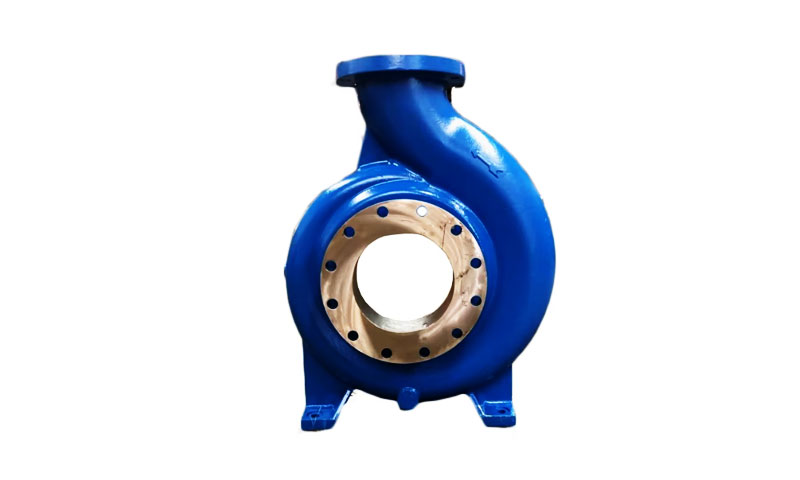1. Ievads
Pump bodies are structural and hydraulic housings that convert driver energy into fluid motion. They commonly contain volutes, impeller seats, bearing bosses, flanges and internal passages.
The manufacturing route chosen for a pump body sets achievable geometry, metalurģija, cost and lead time.
Investment casting stands out where geometry is complex (internal guide vanes, thin webs, integrated bosses), tolerances are tight, and high-integrity alloys (nerūsējoši tēraudi, niķeļa sakausējumi, bronzas) nepieciešami.
2. What Is an Investment Casting Pump Body?
Definition and core functionality
Tāds investīciju liešana pump body is a pump housing produced by the lost-wax (ieguldījums) liešanas metode.
A wax (vai polimērs) pattern of the pump body is created, coated in refractory ceramic to build a shell, the wax removed by heating, and molten metal poured into the ceramic mold.
The fired shell is broken away after solidification to reveal a near-net cast pump body that is subsequently finished and inspected.
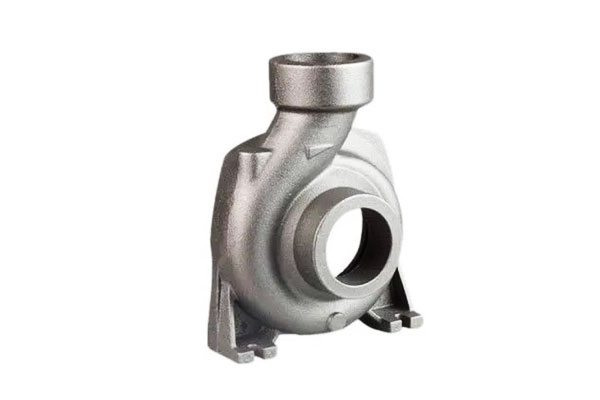
Typical specifications and dimensions
- Part mass: investment cast pump bodies usually range from a few hundred grams to tens of kilograms per piece; many foundries routinely cast pump bodies from ~0.5 kg up to ~50–100 kg depending on plant capability.
- Sienas biezums: typical nominal walls for stainless or nickel alloys: 3–12 mm; minimum thin sections down to 1–2 mm are achievable in selected alloys and process control.
- Dimensional tolerance (tikpat ietērpts): general investment cast tolerances commonly fall in ± 0,1–0,5 mm for small features; percent-based tolerance of ±0.25–0.5% linear is a practical rule of thumb.
Critical machined features are usually left with machining allowance (0.2–2.0 mm depending on casting accuracy). - Virsmas apdare (tikpat ietērpts): typical Ra 1.6–3,2 μm (50–125 min) for standard ceramic shells; fine shells and careful pouring can produce Ra ≈ 0.8–1.6 μm.
Sealing faces or bearing journals are machined/lapped to much finer Ra (≤ 0.2 μm) as required.
3. Dizaina apsvērumi
Investment casting enables complex geometry, but good design practice maximizes quality and minimizes cost.
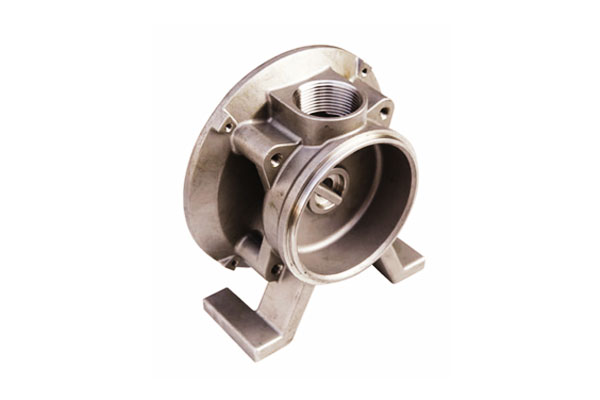
Hydraulic performance requirements
- Flow passages & volutes: smooth fillets and controlled convergence avoid separation and cavitation.
Internal fillet radii should be generous (≥ 1–2× wall thickness) to reduce turbulence. - Impeller seat alignment: concentricity and perpendicularity are critical — plan for machined bores and datum features.
- Clearances: pump clearances at impeller overhangs and seal faces must be maintainable by post-cast machining.
Structural requirements
- Stress & nogurums: consider cyclical loads; use finite-element analysis to identify local stress risers.
Cast metallurgy (graudu izmērs, segregācija) affects fatigue life—design to avoid thin, highly stressed bosses without proper filleting. - Vibration: stiff webs and ribs help raise natural frequencies; investment casting allows ribs to be integrated into the body.
Korozija & valkāt
- Materiālu izvēle: choose alloy based on fluid chemistry (ph, hlorīdi, erozīvas daļiņas, temperatūra).
For seawater, duplex or cupronickel may be required; for acids, Hastelloy or appropriate nickel alloys. - Erosion resistance: smooth internal surfaces and sacrificial coatings (cietsirdīgs, termiskais aerosols) are options where particulate slurry is present.
Izmēru pielaides & virsmas apdare
- Kritiskās pazīmes: designate which faces/bores are finish-machined and specify machining allowances (Piem., 0.5–1.5 mm for sandier shells, 0.2–0.6 mm for precision shells).
- Sealing surfaces: specify Ra and flatness; often lapped/polished to Ra ≤ 0.2 μm and flatness within 0.01–0.05 mm depending on pressure class.
4. Materials for Investment Casting Pump Bodies
Material selection is a critical factor in designing and producing investment-cast pump bodies, as it directly affects mechanical performance, izturība pret koroziju, ražošana, un kalpošanas laiks.
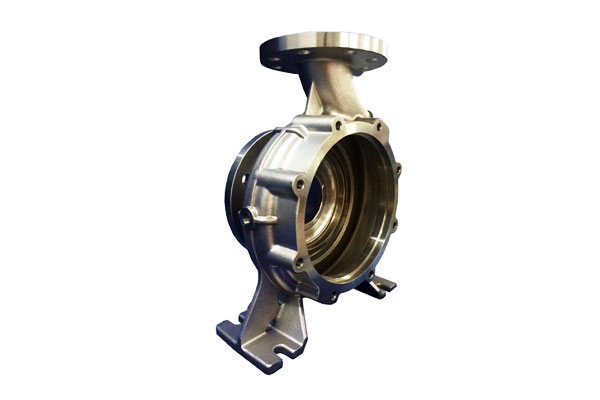
| Materiālo kategorija | Piemērs Sakausējumi | Galvenās īpašības | Tipiskas lietojumprogrammas | Liešanas apsvērumi |
| Austenīts Nerūsējošais tērauds | 304, 316Lukturis | Lieliska izturība pret koroziju, mērena izturība, Laba metināmība; Stiepts: 480–620 MPa, Ienest: 170–300 MPa, Pagarināšana: 40–60% | General chemical pumps, ūdens apstrāde, pārtika & dzēriens | Good molten fluidity, low hot-cracking risk, easy post-machining |
| Dupleksa nerūsējošā tērauda | 2205, 2507 | Lielas izturības (Yield 450–550 MPa), superior chloride stress corrosion resistance | Marine and offshore pumps, aggressive chemical environments | Requires controlled temperature; post-casting heat treatment to prevent sigma phase |
Niķeļa sakausējumi |
Neiebilstība 625, 718; Hastelijs | Izcila izturība pret koroziju, augstas temperatūras spēks, izturība pret oksidāciju | Ķīmiskā apstrāde, enerģijas ražošana, eļļas & gāze | High melting points (≈1450–1600 °C); careful mold preheating and controlled pouring needed; difficult machining |
| Bronza and Copper Alloys | C93200, C95400 | Lieliska jūras ūdens izturība pret koroziju, laba nodiluma pretestība, antifouling; lower mechanical strength | Jūras sūkņi, jūras ūdens dzesēšana, hidrauliskās sastāvdaļas | Lower melting points (≈1050–1150 °C) simplify casting; low thermal cracking risk; mechanical strength lower than stainless/nickel |
5. Investment Casting Process for Pump Bodies
Investīciju liešana, pazīstams arī kā zaudēto vaska liešana, enables the production of pump bodies with complex geometries, plānas sienas, un augstas dimensijas precizitāte.
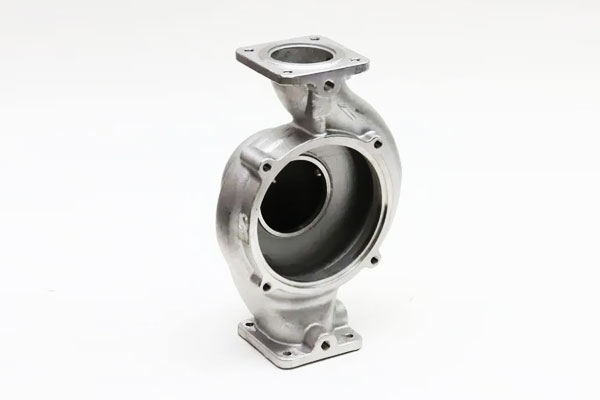
The process consists of several critical steps:
| Solis | Apraksts | Galvenie apsvērumi |
| 1. Vaska modeļa radīšana | Molten wax is injected into precision molds to form replicas of the pump body. | Ensure uniform wall thickness; maintain dimensional accuracy ±0.1 mm; use high-quality wax to prevent distortion. |
| 2. Assembly of Wax Tree | Individual wax patterns are attached to a central wax sprue to form a tree for batch casting. | Sprue design affects metal flow; minimize turbulence during pouring. |
| 3. Keramikas apvalka ēka | Repeated dipping in ceramic slurry and stuccoing with fine refractory sand creates a strong, karstumizturīga apvalks. | Target shell thickness (5–10 mm) depends on pump body size; avoid cracks and porosity in the shell. |
| 4. Dewaxing and Mold Firing | Wax is melted out (autoclave or kiln), atstājot dobumu; the ceramic shell is then fired to remove residues and strengthen the mold. | Temperature ramping must be controlled to prevent shell cracking; residual wax must be fully removed. |
5. Metāla liešana |
Izkusis metāls (nerūsējošais tērauds, nickel alloy, vai bronza) is poured into the preheated ceramic mold under gravity or vacuum-assisted conditions. | Pouring temperature and rate must ensure complete filling; control turbulence and prevent oxide formation. |
| 6. Sacietēšana un dzesēšana | Metal solidifies inside the mold; cooling rates affect microstructure, Mehāniskās īpašības, un atlikušais stress. | Thick sections may require controlled cooling to prevent porosity; thin walls must avoid hot tearing. |
| 7. Čaumalas noņemšana | Ceramic shell is broken away mechanically, often using vibration, sand blasting, or chemical dissolution. | Avoid damaging intricate pump channels or flanges. |
| 8. Finishing and Cleaning | Residual ceramic, gating system, and surface imperfections are removed via grinding, šāvienu spridzināšana, or chemical cleaning. | Maintain dimensional tolerances; prepare surfaces for subsequent machining or coating. |
6. Operācijas pēc izvietošanas
After the pump body is removed from the ceramic shell, several post-casting operations are performed to ensure the component meets functional, dimensiju, un virsmas kvalitātes prasības.
These operations are critical for high-performance applications in chemical, jūras, un rūpniecības nozares.
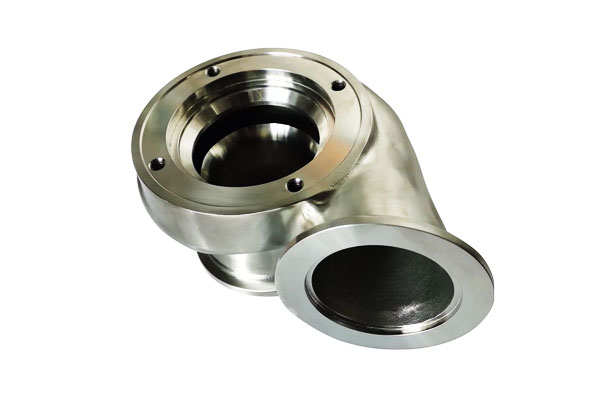
Termiskā apstrāde
Termiskā apstrāde is applied to relieve residual stresses, Uzlabot elastību, and optimize mechanical properties:
- Stresa mazināšanas atlaidināšana: Heating to 550–650 °C for stainless steels reduces residual stress from casting and prevents distortion during machining.
- Risinājumu rūdīšana: Applied for stainless steels and nickel alloys to homogenize microstructure and dissolve unwanted precipitates, ensuring corrosion resistance and consistent hardness.
- Aging or Precipitation Hardening (for certain alloys): Enhances strength and wear resistance in high-performance materials.
Apstrāde
Critical dimensions such as flanges, urbums, mating surfaces, and threaded ports are machined to meet tight tolerances.
Typical machining operations include turning, frizēšana, urbšana, and boring. Machining ensures:
- Dimensional tolerances of ±0.05–0.1 mm for precise assembly.
- Smooth sealing surfaces to prevent leaks in high-pressure applications.
Virsmas apdare
Virsmas apdare pastiprina izturību pret koroziju, nodilums pretestība, un estētika:
- Pulēšana: Improves smoothness for sealing faces and internal channels.
- Šāvienu spridzināšana: Removes residual ceramic particles and creates a uniform surface for coating or painting.
- Pārklājumi: Optional chemical or electroplated coatings (Piem., niķelis, Ptfe) enhance corrosion resistance and reduce friction.
Nesagraujoša pārbaude (Ndt)
To detect defects such as porosity, plaisas, or inclusions, NDT is performed:
- Radiogrāfija (Rentgenstars): Identifies internal voids and inclusions.
- Ultraskaņas pārbaude (Ut): Detects subsurface flaws in thick sections.
- Krāsvielu iespiešanās pārbaude (Pt): Reveals surface cracks and porosity.
Cleaning and Inspection
Beidzot, pump bodies are cleaned to remove residual machining oils, Gruveši, or salts. Dimensional and visual inspections verify compliance with specifications before assembly or shipment.
7. Quality Assurance and Testing
Kvalitātes nodrošināšana (QA) is critical in ensuring that investment casting pump bodies meet design specifications, performance standards, un nozares prasības.
A systematic QA approach combines dimensional checks, mehāniskā pārbaude, and non-destructive evaluation to detect defects and confirm functional integrity.
Dimensiju pārbaude
Dimensional verification ensures that the pump body conforms to design drawings and tolerances:
- Koordinēt mērīšanas mašīnas (CMM): Measure complex geometries, urbums, atloki, and mounting surfaces with accuracy of ±0.01–0.05 mm.
- Gauge Tools: Thread gauges, plug gauges, and height gauges verify critical features quickly in production.
- Virsmas raupjuma mērīšana: Confirms finishing requirements for sealing faces and internal channels (Piem., Ra ≤0.8 μm for hydraulic components).
Mechanical Property Verification
Mechanical testing validates that the material meets required strength, elastība, un cietība:
- Stiepes pārbaude: Measures yield strength, ultimate tensile strength, un pagarināšana, ensuring the material can withstand operational loads.
- Cietības pārbaude: Rockwell or Vickers testing confirms that heat treatment and material processing achieved the desired hardness.
- Trieciena pārbaude (Ja nepieciešams): Evaluates toughness for applications exposed to fluctuating loads or shock.
Nesagraujoša pārbaude (Ndt)
NDT techniques detect hidden defects without damaging the part:
- Radiogrāfija (X-ray/CT Scanning): Identifies internal porosity, ieslēgumi, and voids, particularly in thick sections.
- Ultraskaņas pārbaude (Ut): Detects internal cracks, tukšumi, or delaminations in dense materials like stainless steel and nickel alloys.
- Krāsvielu iespiešanās pārbaude (Pt): Reveals surface cracks, pinholes, or fine porosity not visible to the naked eye.
- Magnētisko daļiņu pārbaude (Kalna attālums): Applied for ferromagnetic alloys to detect surface and near-surface discontinuities.
Common Casting Defects and Mitigation Strategies
- Porainība: Minimized through proper gating, ventilācija, and controlled solidification rates.
- Saraušanās dobumi: Addressed via riser design and thermal management.
- Auksti izslēgti un nepareizi: Avoided by maintaining optimal pouring temperatures and smooth flow in complex geometries.
- Surface Inclusions: Controlled by using high-purity alloys and proper degassing techniques.
8. Advantages of Investment Casting for Pump Bodies
- Sarežģīta ģeometrija: iekšējie fragmenti, thin walls and integrated bosses with minimal secondary assembly.
- Gandrīz tīkla forma: reduces material removal vs. rough machining from bar or billet — often 30–70% less machining Par sarežģītām detaļām.
- Augstas dimensijas precizitāte & virsmas apdare: less secondary finishing for many features compared with sand casting.
- Alloy flexibility: cast many stainless and nickel alloys with good metallurgical integrity.
- Small to medium production flexibility: tooling for wax patterns is relatively inexpensive vs. large die tooling, enabling economic runs from prototypes to thousands of parts.
9. Ierobežojumi un izaicinājumi
- Cost for very large parts: above certain sizes (bieži >100 kg) investment casting becomes uneconomical compared with sand casting or fabricating/ welding.
- Sagatavošanās laiks: pattern tooling, shell building and firing add lead time—prototype timelines usually measured in weeks.
- Porosity risk in thick sections: thick bosses or large cross-sections require careful gating, chills or segmenting to avoid shrinkage.
- Surface finish and tolerances depend on shell system: achieving ultra-fine finishes or extremely tight as-cast tolerances requires premium ceramic systems and process control.
10. Rūpniecības pielietojumi
Investment casting pump bodies are used across a broad spectrum of industries due to their complex geometry capabilities, materiāla daudzpusība, un augstas dimensijas precizitāte.
The process allows engineers to design optimized hydraulic passages, plānas sienas, and integrated mounting features that improve pump efficiency and longevity.
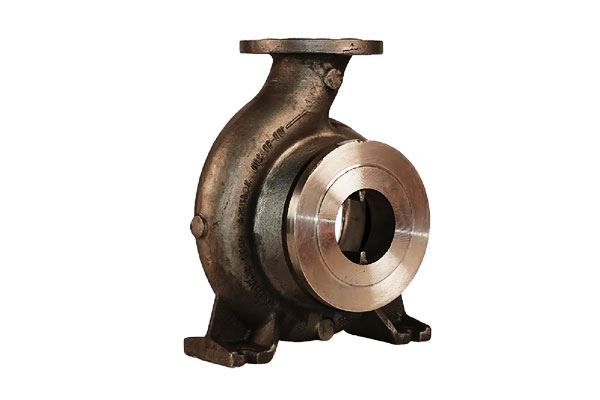
Chemical Processing Pumps
- Vide: Corrosive fluids such as acids, caustics, un šķīdinātāji.
- Materials Used: Nerūsējoši tēraudi (316Lukturis, divstāvu) and nickel alloys (Hastelijs, Neiebilstība).
- Pamatojums: Investment casting enables intricate internal channels, minimizing turbulence and ensuring uniform flow, critical for chemical process reliability.
Water and Wastewater Pumps
- Vide: High-volume pumping, abrasive suspended solids, and variable pH levels.
- Materials Used: Bronza, Dupleksa nerūsējošā tērauda, and corrosion-resistant cast irons.
- Pamatojums: Thin-wall, smooth internal passages reduce clogging and energy losses, improving efficiency in municipal and industrial water systems.
Marine and Offshore Pumps
- Vide: Saltwater exposure, high-pressure operation, and cyclical mechanical stress.
- Materials Used: Vara sakausējumi (jūras misiņš, bronza), Duplekss nerūsējošais tērauds.
- Pamatojums: Resistance to corrosion and biofouling is critical; investment casting allows seamless, complex geometries to reduce maintenance and improve service life.
Eļļas & Gas and Power Generation Pumps
- Vide: Augstas temperatūras, high-pressure fluids, and hydrocarbon-based media.
- Materials Used: High-nickel alloys (Neiebilstība, Hastelijs), nerūsējošais tērauds, and cobalt-based alloys.
- Pamatojums: Investment casting supports high-strength materials and precise tolerances necessary for critical applications such as turbine lubrication, chemical injection, and offshore drilling.
Specialty and Custom Pumps
- Vide: Laboratory, farmaceitisks, or food processing applications requiring hygienic and precision performance.
- Materials Used: Nerūsējošais tērauds (304, 316Lukturis), titāns, vai niķeļa sakausējumi.
- Pamatojums: Gludas virsmas, stingras pielaides, and complex geometries achieved by investment casting ensure minimal contamination risk and compliance with regulatory standards.
11. Salīdzinošā analīze
| Iezīmēt / Kritēriji | Investīciju liešana | Smilšu liešana | Machining from Solid |
| Ģeometriskā sarežģītība | Excellent – thin walls, iekšējie kanāli, intricate features achievable | Moderate – limited by core placement and mold stability | Limited – complex internal geometries often impossible without assembly |
| Izmēra precizitāte | High – ±0.1–0.25 mm typical | Moderate – ±0.5–1.0 mm | Very High – ±0.05 mm achievable |
| Virsmas apdare (Ra) | Fine – 1.6–3.2 μm typical; can be polished | Rough – 6–12 μm; requires machining for precision | Excellent – 0.8–1.6 μm achievable with finishing |
| Materiālo opcijas | Wide – stainless steels, niķeļa sakausējumi, bronza, vara sakausējumi | Wide – iron, tērauds, bronza, alumīnijs | Wide – depends on machinable stock availability |
| Partijas lielums | Low-to-medium – 1–1000+ parts | Medium-to-high – economical for large, vienkāršas daļas | Low – material waste increases cost for large parts |
| Sagatavošanās laiks | Moderate – wax pattern & shell building required | Short-to-moderate – mold preparation relatively quick | Variable – depends on machining complexity |
Materiālo atkritumu atkritumi |
Low – near-net shape reduces scrap | Moderate – gating and risers generate some waste | High – subtractive process creates chips and offcuts |
| Izmaksas par daļu | Moderate-to-high – tooling and process steps increase cost, economical for complex parts | Low-to-moderate – simpler molds, larger parts cheaper | High – extensive machining on large, complex parts is expensive |
| Izturība & Godīgums | Excellent – dense microstructure, minimal porosity if controlled | Moderate – risk of sand-related inclusions and porosity | Excellent – homogeneous, no casting defects |
| Post-Processing Required | Often minimal – some machining, apdare | Usually significant – machining and finishing required | Minimal – final finishing for tight tolerances only |
| Tipiskas lietojumprogrammas | Pump bodies with thin walls, complex hydraulic channels, izturība pret koroziju | Liels, simple pump housings or structural components | Custom or prototype pump bodies requiring extreme precision |
12. Secinājums
Investment casting pump body combines design freedom with metallurgical integrity, making them an excellent choice for many fluid-handling applications—especially where complex internal geometry, exotic alloys or tight tolerances are required.
Success depends on early design for casting, informed material selection, careful process control (izliešana, shelling, termiskā apstrāde), and robust QA/NDT programs.
For critical pump systems—marine, chemical or power generation—investment casting can deliver reliable, economical components when specified and executed correctly.
FAQ
What maximum size of pump body can be investment cast?
Typical shop practice ranges up to ~50–100 kg per part, but the practical maximum depends on foundry capability and economics.
Very large pump bodies are more often produced by sand casting or fabricating/welding.
How much machining allowance should I design into an investment casting?
Ļaut 0.2–2,0 mm depending on the criticality and shell precision. Specify tighter allowances only where the foundry guarantees precision shells.
Which material is best for seawater pump bodies?
Duplex stainless steels and selected copper-nickel alloys are common choices due to superior chloride pitting resistance and biofouling performance; final selection depends on temperature, velocity and erosion conditions.
What is the typical turnaround time for an investment-cast pump body?
Small production runs typically take 4–8 nedēļas from pattern approval to finished parts; single prototypes can be faster with 3D-printed patterns but still require shell firing and melt schedules.
How do I specify acceptance criteria for porosity?
Use industry NDT standards (radiogrāfija, Ct, Ut) and define acceptance levels in percent porosity by volume or via reference images.
Critical pressure-retaining pump bodies often require porosity <0.5% by volume and radiographic acceptance per customer standard.
